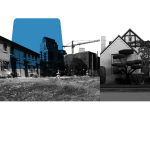We have a new understanding of how housing influences health. Stability, quality, affordability, location — all these factors affect our physical and mental well-being.
We know that children whose families are behind on rent are more likely to face tremendous health challenges. They’re often in fair or poor health, food insecure, at risk of developmental delays, and below average in weight (an indication of undernutrition).
Therefore, a stable, affordable home can act like a vaccine, providing multiple long-lasting benefits on both the individual level and the community level.
We’re already seeing what an affordable home can do for kids and communities. Take this example: Children in food-insecure families are at risk for being underweight. But food-insecure kids whose families receive a housing subsidy are much less likely to be underweight than similar children whose families are eligible for housing help but are not receiving it. So, kids living with families with a housing subsidy are not only more likely to reap the benefits of a home they can afford, they are also more likely to be at a healthy weight despite being food insecure.
At the community level, research from Dr. Andrew Beck at Cincinnati Children’s Hospital showed kids with asthma who lived in communities with fewer housing code violations had fewer emergency room visits for asthma. This suggests code enforcement could help build community resilience and protect kids from suffering asthma attacks.
It is time to face the fact that we cannot solve the affordable housing crisis with bandages like time-limited vouchers, and we can’t have people living in substandard housing. We need real, sustained treatment — a “housing vaccine” — to provide stable, decent homes families can afford.
The Alameda County Public Health Department (ACPHD) is ensuring a housing vaccine is available for the residents they serve. They are building the evidence base to educate decision makers and the public about the causes of health inequities, and they’re linking direct service providers to advocacy work and policy change efforts to fund more affordable housing and protect existing housing. They’re also working with diverse partners to give residents better housing options.
Other public health departments and health care systems can draw inspiration from ACPHD’s work. And there are opportunities to build on the department’s strategies.
Health departments and health care institutions can rethink how they collect, share, and process data about the social determinants of health.
For years, the medical community, knowing that patients who are sicker are harder to take care of and make well, has adjusted for risk. For instance, hospitals that take care of patients with severe heart disease may get higher payments because they need to do more surgery and cardiac rehabilitation to help the patients get better.
But there are new models of risk adjustment. Payments and compensation are no longer exclusively related to medical complexity and the related health care expenses.
Slowly but surely, we’re embracing social risk adjustment to acknowledge that patients living with certain social risks, such as housing insecurity, may be sicker and harder to make well, too. And when it comes to housing, we can use social risk adjustment to determine the resources needed to help patients living in different neighborhoods and conditions be in better health.
To date, measurement of social risk has been challenging. Typical social risk adjustment proposals have tended to focus on indicators that are widely available, such as income. But by limiting our analyses to income levels, we miss important underlying reasons why the poorer people typically use more health care.
In Massachusetts, Medicaid administrators are attempting to understand and adjust for the social risks that stem from housing issues. They have proposed additional payments to health systems for patients who are homeless, housing insecure, or living in a neighborhood with a high Neighborhood Stress Score. This metric shows more frequent health care utilization among patients from neighborhoods with such conditions as low high school graduation rates and high unemployment.
This is important. With this information, insurance providers could acknowledge the social risks associated with housing challenges and give additional payments to health systems to help patients facing these challenges. Health systems would have to find ways to systematically identify struggling patients, then help keep them out of the hospital by improving housing and neighborhoods.
Ensuring that residents have a right to representation is also shown to have protective health benefits. And investing in more affordable housing ensures residents are able to access housing in perpetuity.
Innovations in data collection give rise to issues that public health departments and health care providers may implicitly understand, but lack the tools to address. So if the strain from home is making us sick, what is a public health department or hospital to do?
1) Identify patients with poor quality, unstable, or unaffordable housing.
ACPHD is able to do this through its direct service providers. Children’s HealthWatch has identified sample questions on housing insecurity, such as “In the past 12 months, how many places have you lived?” and “In the past 12 months, was there a time where you did not have a steady place to stay or stayed in the shelter?”
Housing insecurity comes in many forms, and all are associated with poor health outcomes. Health systems can use diagnostic codes, as created by the International Classification of Disease (ICD) system, to add housing insecurity experiences to problem lists in the medical record. For example, in the 10th iteration of the ICD system, there are ICD-10 codes for homelessness and housing instability to track patients’ risks.
2) Develop interventions to address housing strains.
As a public health department, ACPHD doesn’t provide housing. But by developing partnerships with local organizations, advocates, and agencies, it is better able to serve its residents.
Medical-legal partnerships are another possible support service in communities. These partnerships integrate legal services into health care to address unlawful conditions, such as substandard housing or evictions, known to make people sick. Eviction prevention funds can buffer against the harmful effects of eviction and create more stable homes for kids, so they can stay in their schools and their parents can keep their jobs. Other programs can link families to other resources such as food and energy subsidies, which can offset other strains, allowing families to focus on addressing their housing needs.
3) Develop strong policies and practices.
As ACPHD has shown us, it is important to look at housing quality policies, such as proactive rental inspection programs, and policies that support stability and affordability, such as tenant protection ordinances. Public health departments can analyze the health effects of specific housing policies and explain the connections to decisionmakers.
Ensuring that residents have a right to representation is also shown to have protective health benefits. And investing in more affordable housing ensures residents are able to access housing in perpetuity. Hospitals, insurers, and health care providers can use their investment portfolios to help preserve or expand affordable housing.
ACPHD is creating a common language to connect housing diagnoses and medical diagnoses. Linking these conditions through data creates opportunities for housing solutions to be health solutions, motivating community members and policymakers to find those solutions together.
Megan Sandel, MD, MPH, is a member of the BLOCK Project’s Community of Practice and the Associate Director of the GROW clinic at Boston Medical Center and a Principal Investigator with Children’s Health Watch.

